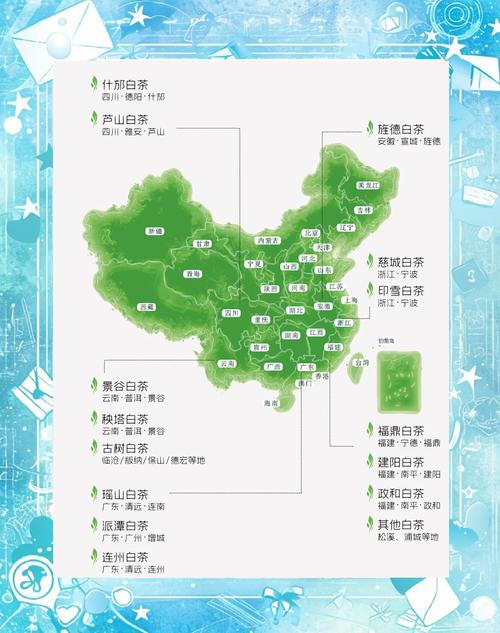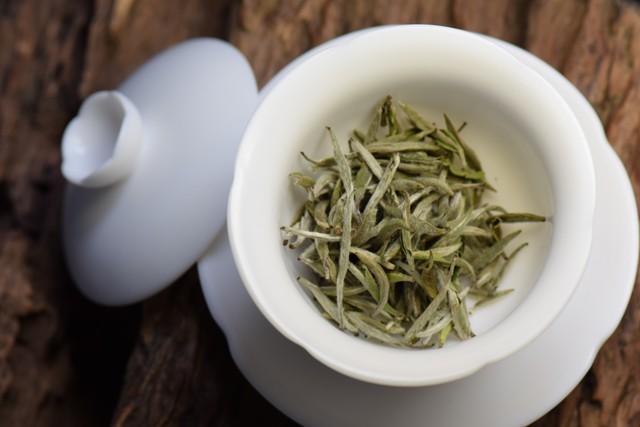White tea, a specialty of China, is renowned for its delicate flavor, natural sweetness, and numerous health benefits. This unique tea variety is primarily produced in specific regions of China, each contributing its unique terroir and production techniques to the final product. This article explores the geographical distribution of Chinese white tea, focusing on its main producing areas, growing environments, and varietal characteristics.

Fujian Province: The Cradle of White Tea
Fujian Province stands as the epicenter of Chinese white tea production, with a history spanning over 200 years. The province’s favorable climate, fertile soil, and abundant rainfall provide ideal conditions for cultivating high-quality white tea. The main producing regions within Fujian include Fuding, Zhenghe, Songxi, and Jianyang.
- Fuding: Known as the “Hometown of Chinese White Tea,” Fuding boasts a warm and humid climate, surrounded by mountains and the sea. Its white teas, particularly Baihao Yinzhen (Silver Needle) and Baimudan (White Peony), are celebrated for their silvery appearance, fresh aroma, and sweet taste. The tea plants here, such as Fuding Da Bai and Fuding Da Hao, are characterized by their fat buds covered with white downy hairs, making them excellent raw materials for white tea production.
- Zhenghe: Located in the southeast coastal hilly region of Fujian, Zhenghe benefits from a cool summer climate due to its moderate altitude. Zhenghe white tea, mainly produced in Shitun, Dongping, and Xiongshan towns, is known for its strong aroma, fresh taste, and enduring quality. Varieties like Fuan Da Bai, Zhenghe Da Bai, and Fuyun 6 are commonly used.
- Songxi and Jianyang: These regions also contribute to Fujian’s white tea production, although to a lesser extent. They share similar climatic conditions and soil types, contributing to the overall quality and diversity of Fujian white tea.
Other Notable Producing Regions
While Fujian dominates the white tea market, other provinces in China also produce notable white teas, albeit in smaller quantities.
- Yunnan Province: Jinggu County in Yunnan is famous for its Jinggu Da Bai Cha (Moonlight White), a large-leaf variety with a rich history. The tea is characterized by its fat buds, white downy hairs, and a mellow, sweet taste with a hint of honey.
- Jiangxi, Zhejiang, and Taiwan: These regions also have white tea production, albeit on a smaller scale. Each region imparts its unique terroir and production methods, resulting in diverse white tea offerings.
Growing Environment and Varietal Characteristics
White tea thrives in environments with ample rainfall, sufficient sunlight, and fertile soil. The ideal soil types for white tea cultivation include acidic mountain yellow soil, sandy yellow soil, and red-yellow soil. The tea plants prefer diffuse light and high humidity, making mountain valleys with rich mist the perfect habitat.
The main varieties of white tea include Baihao Yinzhen, Baimudan, Gongmei, and Shoumei, each with distinct appearance and flavor profiles. For instance, Baihao Yinzhen is made entirely from fat buds covered with white downy hairs, while Baimudan features one bud and one or two leaves, resembling a peony flower.
Conclusion
Chinese white tea, with Fujian Province as its heartland, showcases the diverse terroirs and production techniques across various regions. Each producing area contributes its unique characteristics to the final product, making white tea a treasured beverage enjoyed worldwide. Whether it’s the fresh sweetness of Fuding white tea or the mellow taste of Jinggu Da Bai Cha, Chinese white tea continues to captivate tea enthusiasts with its delicate flavor and health benefits.



